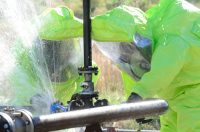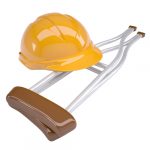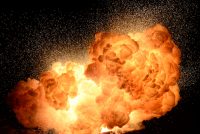Category: Special Topics in Safety Management
Safety is a process, and as such, needs to be managed. This section offers resources to create a viable safety program, sell it to senior management, train supervisors and employees in using it, and then track and report your progress. Look also for ways to advance your own skills in these areas, both for your current job, and those that follow.
Today, we present some questions about ladder safety sent to Safety.BLR.com by safety professionals and other managers, with answers from our experts. Are ladder safety cables required to have an annual inspection? 1926.1053(b)(15) Ladders shall be inspected by a competent person for visible defects on a periodic basis and after any occurrence that could affect […]
A NIOSH research team finds that 43 percent of fatal falls in the U.S. involve a ladder. Among workers, about 20 percent of fall injuries involve ladders.
By Tom Reddon Rough terrain forklifts require the right operators to handle them or it can lead to serious accidents. The workhorses are designed to handle heavy loads and operate on challenging terrain. Most rough terrain forklift accidents are caused by operator error. The right training procedures can help your employees understand how to carefully […]
Make sure employees who get anywhere near hazardous materials understand the risks and the precautions. Depending on the hazardous material and the amount, hazards can range from moderate to deadly. Your employees also need to realize that hazardous substances can be hazardous in different ways. They can be:
When an employee is out of work due to an injury or illness, it’s in everyone’s best interest to get that person back on the job safely and as soon as possible.. For employers, an effective return-to-work program can reduce workers’ compensation costs and improve employee morale and productivity. For employees, returning to work can […]
Take these steps before, during, and after claims are filed to reduce workers’ comp costs. Workers’ compensation costs keep rising. But fortunately, there are many measures your organization can take to reduce costs.Before a Claim Is Ever FiledTo reduce upfront spending on workers’ compensation: Implement an effective safety program. This reduces your workers’ comp costs […]
Combustible dust explosions have destroyed workplaces and killed employees. Take action now to prevent a disaster. A comprehensive approach to preventing and controlling combustible dust hazards is essential to prevent deadly explosions. Some general rules include the following: Do not allow employees to use compressed air, dry sweeping, or other cleaning methods that can disperse […]
OSHA has issued guidance for its inspectors to determine if makers and importers of chemicals have correctly classified products as combustible dust hazards under the revised Hazard Communication (HazCom) Standard (or HCS). The recent guidance, issued as an interpretation and sent to OSHA regional administrators, affects manufacturers and importers of chemicals (“classifiers”), not users. In […]
Keep older workers safe on the job with these simple strategies.
Statistics show that young workers are twice as likely to be injured on the job as older employees. Reasons young workers may be injured include lack of: Job experience Knowledge Skills Understanding of risks, safety rules, and procedures Good judgment and impulse control Safety training Young workers have more accidents at work because they lack […]










